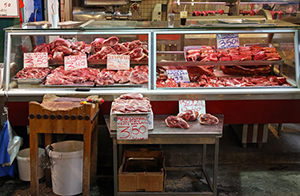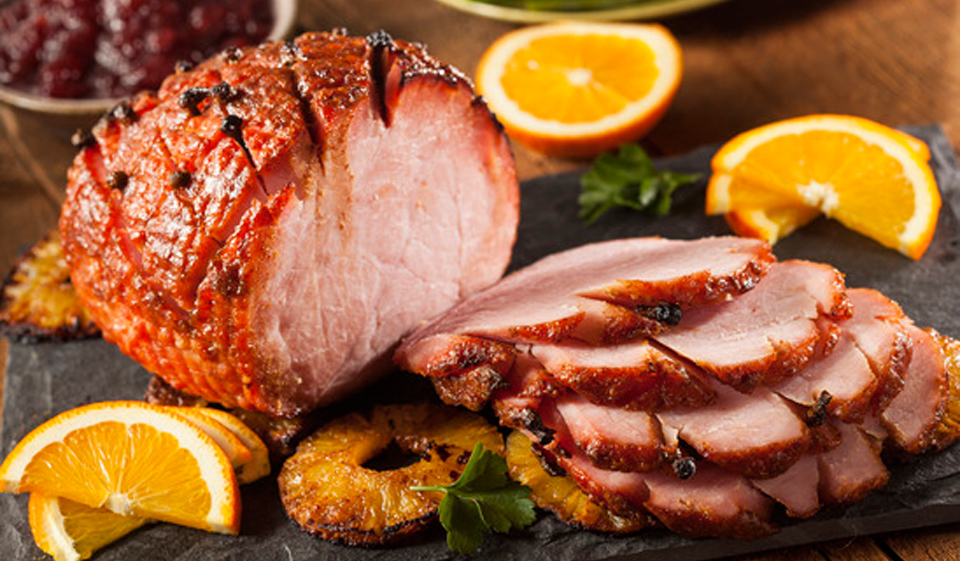Making a Christmas Ham
Ham has been around for what seems like forever. Its origins extend far back into prehistory, with Chinese and Gaelic artisans simultaneously claiming to have been responsible for its invention. Whoever first came up with the idea of preserving meat for longer periods of time by curing it, they’ve contributed enormously to human prosperity. Everyone loves ham – especially during Christmas time.
If you’re looking to serve up a Christmas feast this year, then a huge, Medieval-style leg of ham makes a brilliant centrepiece. But how what exactly is it that separates a great ham from a not-so-great one? Let’s find out!
Get the best ingredients
As with most things cookery-related, securing the right raw ingredients are essential. If you don’t buy quality ham, then no amount of extra herbs, salts and spices is going to make it taste good.
 You should therefore go for the best ham that you can afford. Organic, outdoor-reared pigs – even if we leave to one side any ethical advantages – will produce a superior taste. If you’ve a choice between an enormous cut of cheap ham and a smaller cut of the higher quality stuff, you should always opt for the latter. It’s worth bearing in mind, however, that ham will last a great deal longer than any turkey might, and so you can always elect to stuff your fridge with more than you otherwise might.
You should therefore go for the best ham that you can afford. Organic, outdoor-reared pigs – even if we leave to one side any ethical advantages – will produce a superior taste. If you’ve a choice between an enormous cut of cheap ham and a smaller cut of the higher quality stuff, you should always opt for the latter. It’s worth bearing in mind, however, that ham will last a great deal longer than any turkey might, and so you can always elect to stuff your fridge with more than you otherwise might.
In the run-up to Christmas, there will be many farmer’s markets across the country. If you’re looking to get a high-quality ham – or, indeed, any other foodstuff – then it’s well worth making the trip to one of your local farmer’s markets in search of one. Your local butcher is also worth a visit – they’ll be able to tell you all you need to know about the ham, from where it came from to what to do with it.
If you’re looking for high-quality ham in the supermarket, then you’ll need to pay close attention to the packaging. There are several bodies which help to maintain food standards in the UK and each allows their respective logos to be emblazoned upon approved foodstuffs.
The red tractor logo signifies that the ham in question has been made according to the standards of welfare set by Red Tractor, which is an industry body set up to help the customer pick out the best possible food. You might also look for the RSPCA’s freedom food logo, which consists of an F in a blue circle. The RSPCA’s word carries slightly greater weight, as it exists independent of the food industry.
The RSPCA standard should be considered a bare minimum if you want to have an enjoyable experience eating your Christmas ham. An intensive pig farm is not a very pleasant place. The pigs there lead miserable lives. Their diets are overly rich in protein, in order that they grow at an unnaturally fast pace. The result is a meat which is lacking in flavour.
Cheap ham, in other words, is both unethical and flavourless. High-quality ham, by contrast, is bursting with flavour. The choice is not a difficult one!
Cure it!
Once you’ve secured yourself a leg of pork, you’ll want to cure it. This can be done in one of several ways. You can smoke it, placing it into a specially-made outdoor building and blasting it with smoke from a wood fire until the meat absorbs all of that woody flavour. Obviously, this requires a lot of special facilities, not to mention patience and expertise, and so only the most intrepid home-enthusiasts attempt it.
Then we have salt-cure, through which salt is added to the meat in order to preserve it. This comes in one of two sorts – there is dry cure, which takes months, if not years, and is preferred by those glorious, posh sorts of ham that come from Italy.
Brine cure is the sort most often used for home-made Christmas ham. It takes a couple of weeks, but the results are worth it. You’ll need a large pot, and to fully submerge your ham in brine, laced with whatever sweets, spices and other goodies that you decide to throw in there. You can get specially made brining tubs just for this purpose, but you should be fine with anything that’s physically large enough to hold your ham, provided that it’s non-metallic. Store it in a cold place – as close to freezing as possible without actually freezing is ideal.
If you’d prefer, you can buy your pork already cured. This is colloquially known as gammon, though technically the term refers to a smaller piece taken from a whole leg. Buying ready-cured gammon is undoubtedly the easier option, but it does remove quite a bit of the fun, and you’ll be stuck with whatever cure the ham came with.
Cook it!
Generally speaking, there are two ways to cook the gammon – you can either poach it or bake it. If you’re going to bake, then you risk the ham drying out – cover the thing in foil in order to keep the moisture locked in. Some recipes call for filling the tray beneath the wire rack with stock or water.
Poaching takes things a stage further by having the ham wholly submerged in liquid as it cooks. This allows you to infuse the ham with the flavour of whatever it is you’re cooking in. Many weird and wonderful combinations have been attempted over the years. More traditional recipes call for the pork to be poached in a sweet beverage, like cider; more experimental ones call for it to be poached in beer or even coca cola.
You’ll need to cook the thing slowly, depending on how big it is. Place the ham in the pot with enough of your liquid of choice to cover it entirely. Add some all spice, a bay leaf and some cloves and peppercorns and you’ll end up with a wonderfully complex cocktail of flavours combining in the centre of your ham. If you need some citrusy acid to kick through, then you can add orange peel.
You’ll need a meat thermometer in order to get the centre of the ham to around 68 degrees centigrade. A layer of scum will form atop the liquid as it’s cooking – don’t worry about this, just skim it off and dispose of it. You can keep the liquid after you’re done cooking – it’ll be useful for other Christmassy dishes.
Once you’ve poached the ham, you’ll be able to remove the skin quite easily. Take your time and do it right and carefully, and you’ll be left with a big thick layer of fat. This will provide you with that delightful taste of Christmas– especially after it’s absorbed all of the wonderful flavours in the glaze.
Glaze it!
Thus far, our Christmas ham isn’t terribly different from the ordinary sort you might find sliced in a plastic package at your local supermarket. In order to make things that little bit more Christmassy, you’ll need to add the glaze. This is the sticky, sweet outer coating which give the Christmas ham its distinctively dark outer look.
 There are many competing schools of thought when it comes to glazing – even more than there are when it comes to cooking. The things that’s agreed upon is that the glaze should be sweet as well as slightly spicy – but beyond that, almost everything’s up for grabs.
There are many competing schools of thought when it comes to glazing – even more than there are when it comes to cooking. The things that’s agreed upon is that the glaze should be sweet as well as slightly spicy – but beyond that, almost everything’s up for grabs.
In order to attain the right texture, a glaze should have something to dry it out and absorb those flavours. Depending on the recipe you’re following, this might either be mustard powder or flour. Without this component, the glaze is unlikely to not be sticky enough – it’ll slide right off after just a few moment’s cooking! A paste, by contrast, will give you just the right amount of crunch once it’s cooked.
The idea is to get the outer layer of fat crisped up, and to get it to absorb all of the strong flavours of the glaze. Score it in a criss-cross pattern with the sharpest knife you can find. These incisions should be deep enough that you can insert a whole clove into every cross-section. Then apply your glaze. As the ham cooks, this will impart that characteristic spicy flavour into the outer layer of your ham. What’s more, it’ll look the part, too.
Blast the ham in the oven at around 220 degrees C. This will give you a nice dry outer layer while preserving the moisture inside. If you reapply the glaze a few times while the ham is cooking, you’ll be able to achieve a consistent finish. Sprinkle a little extra sugar while you’re at it, too. Keep a close watch, as you don’t want the sugars in your glaze to burn – they’ll turn bitter.
You’ll find that ham is a remarkably forgiving thing to cook. While there are a myriad of different ways of going about it, almost all of them will produce amazing results. The only thing that can potentially ruin your ham is buying a cheap cut of meat to begin with!
